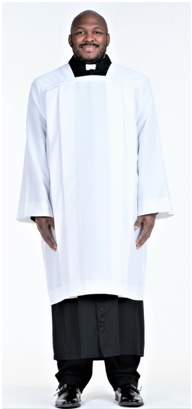The Art of Surplice Making: What to Consider When Shopping for a Surplice
Mar 15th 2023
Surplices are a fundamental garment worn by many clergy members during various religious ceremonies. However, many people are unaware of the detailed process that goes into creating these beautiful and ornate pieces, and how these affect their choice of surplice.
One of the things that enhances the beauty of surplices, for example, is embroidery. Embroidery has been used for centuries to add beauty and elegance to clothing, and clergy garments are no exception. The ornate embroidery on a clergy garment not only serves a decorative purpose but also has a deeper symbolic meaning.
If you're looking to purchase surplices for either yourself or your church, this blog post can help you make the best choice by taking a behind-the-scenes look at the art of surplice making, as well as exploring the role of embroidery and ornamentation in clergy garments.
The Role of the Surplice
Surplices have been worn by religious figures for centuries and are still a vital part of religious tradition today. The surplice is a loose-fitting white tunic made of lightweight fabric that is worn over a cassock or other vestments.
The intricate designs on the surplice vary based on the church and the occasion. Some surplices are adorned with intricate embroidery, while others are more understated.

What Goes into the Creation of a Surplice
1. Choosing the Fabric
The first step in creating a surplice is selecting the fabric. Surplices are typically made from lightweight and breathable fabrics such as cotton or linen.
Once the fabric is chosen, it is pre-washed to ensure it is clean and free of any impurities. The fabric is then laid out flat and cut according to a pattern. The pattern is designed to ensure that the surplice is the correct size and shape and that the design elements are appropriately placed.
2. Bringing Everything Together
The next step is to sew the surplice together. The fabric is sewn together, and the seams are carefully finished to ensure that the garment is durable and comfortable to wear.
The sleeves are then attached to the body of the surplice. The sleeves are typically gathered at the shoulder and are designed to be loose-fitting to allow for ease of movement during religious ceremonies.
3. Adding Embroidery and Other Design Elements in the Surplice
Once the surplice is sewn together, it is time to add any design elements. Some surplices have simple designs, while others are more intricate.
Embroidery is a popular choice for adding design elements to surplices. It is a meticulous and skilled process that involves a great deal of precision.
To create an embroidered surplice, an embroiderer typically uses a needle and thread to carefully sew the design onto the fabric. The process can take many hours to complete, depending on the intricacy of the design.
Embroidery designs can range from simple, geometric patterns to more elaborate designs that feature religious imagery. The use of gold or silver thread in the embroidery adds a touch of grandeur to the garment.
The Role of Embroidery in Clerical Garments
The role of embroidery in surplices goes beyond its aesthetic appeal. Embroidery on a surplice often ranges from religious symbols to floral or geometric patterns. They often also hold a deeper symbolic meaning.
For example, the embroidery on a surplice may feature religious symbols, such as the cross or the Chi Rho, which is a monogram of the first two letters of Christ's name in Greek. These symbols serve as reminders of the wearer's religious beliefs and are intended to inspire worship and reflection in those who see them.

In addition to surplices, embroidery is also used on other types of clergy garments, such as chasubles and stoles.
A chasuble is a sleeveless outer vestment that is worn over the alb during mass. It is often made of richly colored fabrics and is adorned with ornate embroidery.
A stole is a long, narrow strip of fabric that is worn around the neck and draped over the shoulders. It is typically decorated with embroidery that reflects the liturgical season or the wearer's rank within the church hierarchy.
The Evolution of Embroidery in Clerical Garments
The use of embroidery on clergy garments has evolved over time. Throughout history, embroidery has been a mark of distinction for high-ranking members of the clergy, such as bishops and cardinals.
These garments, made from the finest fabrics, were carefully embellished with intricate embroidery patterns that conveyed their esteemed status within the church hierarchy.
Nowadays, the use of embroidery has become more widespread, and it is no longer restricted to just the higher-ups. Embroidery is now seen on a variety of clergy garments, adding an extra touch of elegance and beauty to the garments worn by all members of the clergy.~~
The embroidery designs themselves have also evolved, with many contemporary designs featuring abstract patterns or more modern interpretations of religious symbols.
So if you are looking for high-quality surplices that are crafted with care and attention to detail, you may want to consider shopping with Divinity Clergy Wear.
With a wide range of styles and designs to choose from, you are sure to find the perfect surplice to fit your needs and preferences.
Their commitment to using only the finest materials and their skilled craftsmanship ensure that you will receive a durable and long-lasting garment that you can wear with pride.
Whether you are a member of the clergy or simply looking for a beautiful surplice to wear for special occasions, Divinity Clergy Wear is a great choice for all of your clerical garment needs.
